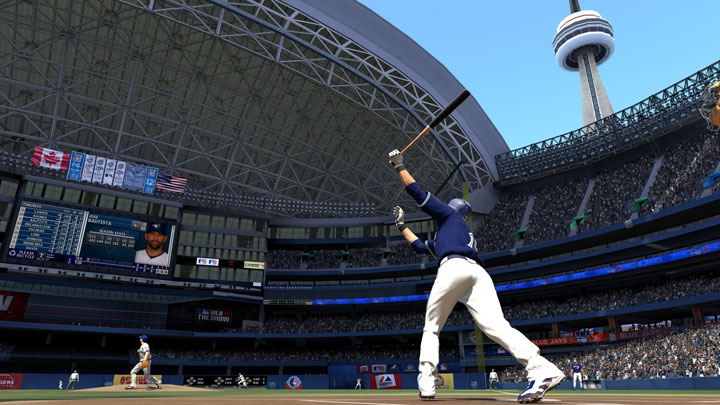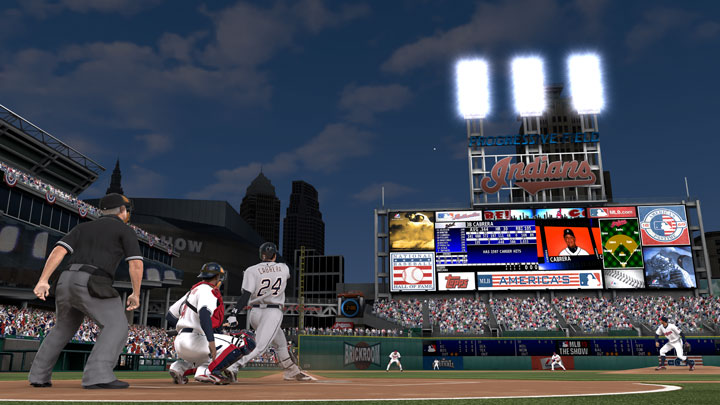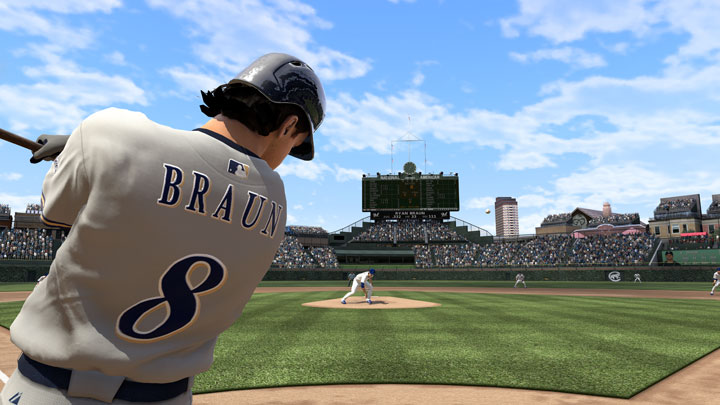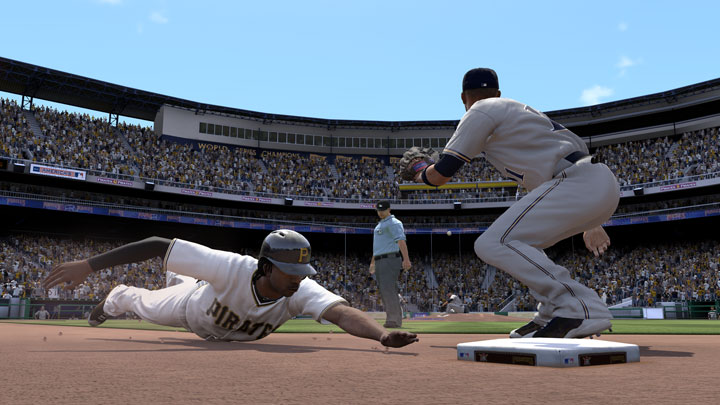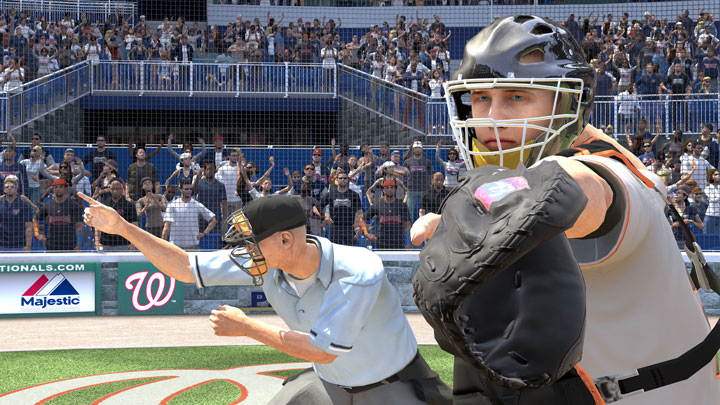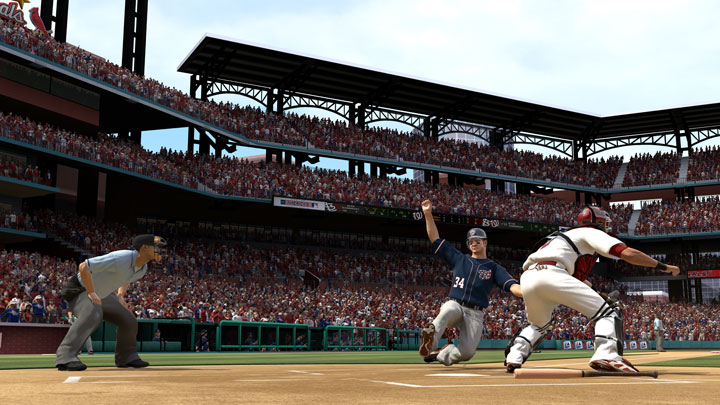Baseball rites of spring are many and varied. From the day that pitchers and catchers report through Opening Day, it seems like not a moment goes by in the springtime without baseball fans noticing how the grand old game is getting warmed up for another season. Now you can add the annual early-March release date of Sony's Cooperstown-caliber MLB: The Show series to the calendar. The game hitting stores has become a big reason for baseball fans to celebrate. And the 2013 edition of this long-running Sony-exclusive series is another masterful re-creation of real baseball, from the pitcher-batter duel at the heart of the game through little moments like getting jammed inside and the satisfaction of turning even a routine 6-4-3 double play. Changes and improvements are subtle for the most part, although some superb tweaks to hitting make the game more approachable than ever. As a result, MLB 13: The Show hits a near-perfect balance between simulation-style realism and the pure arcade thrill of hammering ball with bat.
At first glance, however, MLB 13 doesn't look or sound much different from last year's model. That said, it's one of the best-looking sports games out there, and it would be hard to improve things. Shadow effects are more lifelike than before, especially in day games. Animations include even more running and fielding actions, to the point where you rarely see a player do the same thing twice. Faces are more rounded with realistic features. There doesn't seem to be a player you can't identify upon first glance, whether you're talking about the grizzled, bearded R.A. Dickey or a peach-fuzzed kid like Mike Trout. All that seems to be lacking are some tattoos. So if you're into Jose Reyes' extensive forearm ink, you won't find it here.
Audio is incredible, although much of it has been held over from the past couple of years. Booth jockeys Matt Vasgersian, Steve Lyons, and Eric Karros are dead-on with their observations, which are just about perfectly suited to every play. Some lines have been recycled, of course, although Lyons is a new addition to the team replacing Dave Campbell, so he comes with fresh dialogue. Atmospheric sound effects are even better. Games sound like real baseball on the field, with players talking it up and giving situational advice about the count, the number of outs, and so on. So many sports games resort to canned crowd audio during games, but here, you get background noise that always seems unique to your situation. It's a great way to immerse you in games.
Bigger improvements can be seen in the gameplay. Hitting difficulty has always been one big gripe from fans of past versions of MLB: The Show. The game has never purported to be easy, forcing you to climb the summit of a steep learning curve when stepping into the batter's box. Timing had to be nearly perfect, even with basic push-button swinging on the default difficulty, and it was essential to target the ball with a cursor to make serious contact. This made the game frustrating, especially to newcomers who wanted the instant illusion of being a big-league ballplayer at the dish. Thankfully, hitting has been seriously loosened this year with an opened-up timing window. Now you can get solid wood on the ball even if you don't have your timing absolutely perfect. As a result, you can at least get pieces of tough pitches that you would have just waved at in previous games. Understandably, this does make hitting somewhat easier. But it mostly makes hitting a lot more satisfying, because you can now pound the ball like a major leaguer.
Adjusted batting doesn't kick off offensive explosions, either. You can hit the ball harder more often, sure, but that often means you're clocking a lot of long, loud outs. You're not going to suddenly start slamming the ball over the fences every other at-bat. Going yard might well be a little easier for power hitters, but there is nothing here that would be out of the ordinary in a real Major League contest. Timing remains crucial, as does picking your spots. You can't just go up and flail away at every pitch and expect to do anything but give the opposition easy outs. There is just a little more room for error at the plate, which is very welcome given how tough the game has been in the past, especially for rookies.
The revamped hitting also makes the game more lifelike. As noted above, outs have oomph now. Last year's sad little nubber a few feet down the first-base line is this year's hard ground out right at the sack. You can now more readily fight off tough pitches by fouling away ball after ball to stay alive in fierce duels with pitchers. Before, contact was so tough to come by that you tended to just whiff at stuff on the corners. Now, you can take the likes of Justin Verlander and C.C. Sabathia nine or 10 pitches deep into an at-bat.
New push/pull physics also track how players spray the ball around, labeling them in categories that range from extreme pull to extreme push. This again adds to realism and lets you more accurately tailor at-bats to the skills of individual players, a big help when trying to advance runners. All of these improvements ramp up tension at the plate and give you more of the feeling that anything is possible.
Pitching hasn't changed as much. It might be a little easier to fool opposing batters now, but that's about it. With a control pitcher, you can clock a fair number of Ks now, as long as you throw a smart mix of different pitches and play around with speed and location. Enemy batters aren't as picky as in previous editions of the game. They won't wave at garbage too often, although you can make even the best look foolish with a good mix. Again, this makes for more realistic pitcher-batter duels. The only lingering issue with pitching in need of a fix is the dark circle of the Pulse Pitching mechanics. It remains a little too arcadey, pulsing so fast and making location-setting too gimmicky. The pulsing circle is also too hard to see in front of catchers with dark chest protectors.
Fielding returns pretty much intact, albeit with the addition of a new throwing mechanic called Button Accuracy Throw. A meter governs accuracy, while how hard you press the button governs speed. It's an interesting concept, but it's touchy. It's far too easy to miss your mark on the meter even on routine throws and wind up going into the yellow or red on the meter. This results in firing the ball into the dirt, pulling a player way off a bag, or sailing one into the outfield. How hard you need to push for any given situation is also tough to manage. It's remarkably easy to unload a rocket by mistake when you're trying to underhand toss to first, or half-lob a long throw from behind third.
Most essential features have been almost entirely held over from last year, with only a handful of additions and changes. A new Beginner mode serves as a good introduction to baseball gaming. It starts you off as if you've never seen a bat before, and ramps the difficulty up as your results improve on the rubber and at the plate. All but the most hopeless players might find this mode too simplistic, though at least you can change the settings for different parts of the game. So if you have trouble hitting, but triumph on the mound, you can adjust the difficulty accordingly. Beginner really does simplify things for newcomers, who can be overwhelmed by the huge range of options available, including the usual pile of different control schemes. Move motion controller support returns, but is tiresome and pointless given the superb gamepad control options.
Franchise and season modes are back intact, with the sole big extra being financial modeling that allows small-market teams to up their budgets right away after winning seasons. This makes life a little easier for fans of small fries like the A's and Royals, though it isn't realistic given how quickly the extra budget room kicks in. If this were the case in the real world, the Orioles' surprising run to the playoffs last season would have given them the cash to load up on free agents this past offseason. Stats remain true to life when playing seasons, at least, with offensive, defensive, and pitching numbers staying within realistic parameters. You might well see something like Verlander winning 25 games, although there doesn't seem to be anything improbable here.
Road to the Show remains incredibly addictive, although not much has been added to its simulation of a wannabe pro trying to make his way to the bigs. New camera angles and nifty added options, such as the ability to check what your third-base coach is signaling or check out the ball while running the bases, put you in your player's cleats more effectively than ever before. But the game lacks the sorts of frills seen in the My Player and My Career modes in NBA 2K games. Not that you really need the ability to post on Twitter and design shoes for Nike, but more options here would allow for greater role-playing.
Speedier load and sim times would also be welcome. Loads are sluggish through the entire game, but they really get hard to take when you're playing a position player in Road to the Show and are being forced to constantly wait through long stretches between at-bats and fielding attempts. The new Postseason mode lets you jump right into the race for the World Series without bothering to mess around with those pesky 162 regular season games. Nice touch, but not exactly out of the ordinary in sports gaming; it's a wonder this wasn't added a long time ago.
Online play stays the course. Leagues have been brought forward from last year with minor tweaks to setup options for commissioners, schedules, menus, and that sort of thing. Everything has been organized in a more efficient manner, too, with more options to filter stats, call up historical details to go over previously played league games, and so forth. Nothing here is showstopping, although the changes do address some longstanding gripes from hardcore simmers.
The Show Live has been tossed into the mix to let you follow real developments in the Majors during the 2013 season. It's a nice extra, although it is noticeably similar to the MLB Today mode that was introduced in MLB 2K13 last season. Cross play is available to let PlayStation 3 and PS Vita game owners take on one another, but only in Home Run Derby mode. It's a shame that Sony didn't take this further with full game and career support across the two platforms. You can save games to the cloud and port your seasons of Road to the Show over for use on the Vita, at least.
MLB 13: The Show takes its place in the long line of stellar baseball games that the franchise has produced over the past eight years. It isn't a huge leap over last year's game, which admittedly wasn't a huge leap over its predecessor, but the alterations to the hitting and pitching models make for a much more satisfying game that opens The Show up to a much wider audience. While the game remains challenging, the frustration factor of hitting has been dialed way back, which will draw in new players who want to get good wood on the ball like a real big leaguer. It's too bad that owners of other platforms don't get to enjoy the release of this game every spring at the same time that real major leaguers are taking in some sun en route to Opening Day.
'